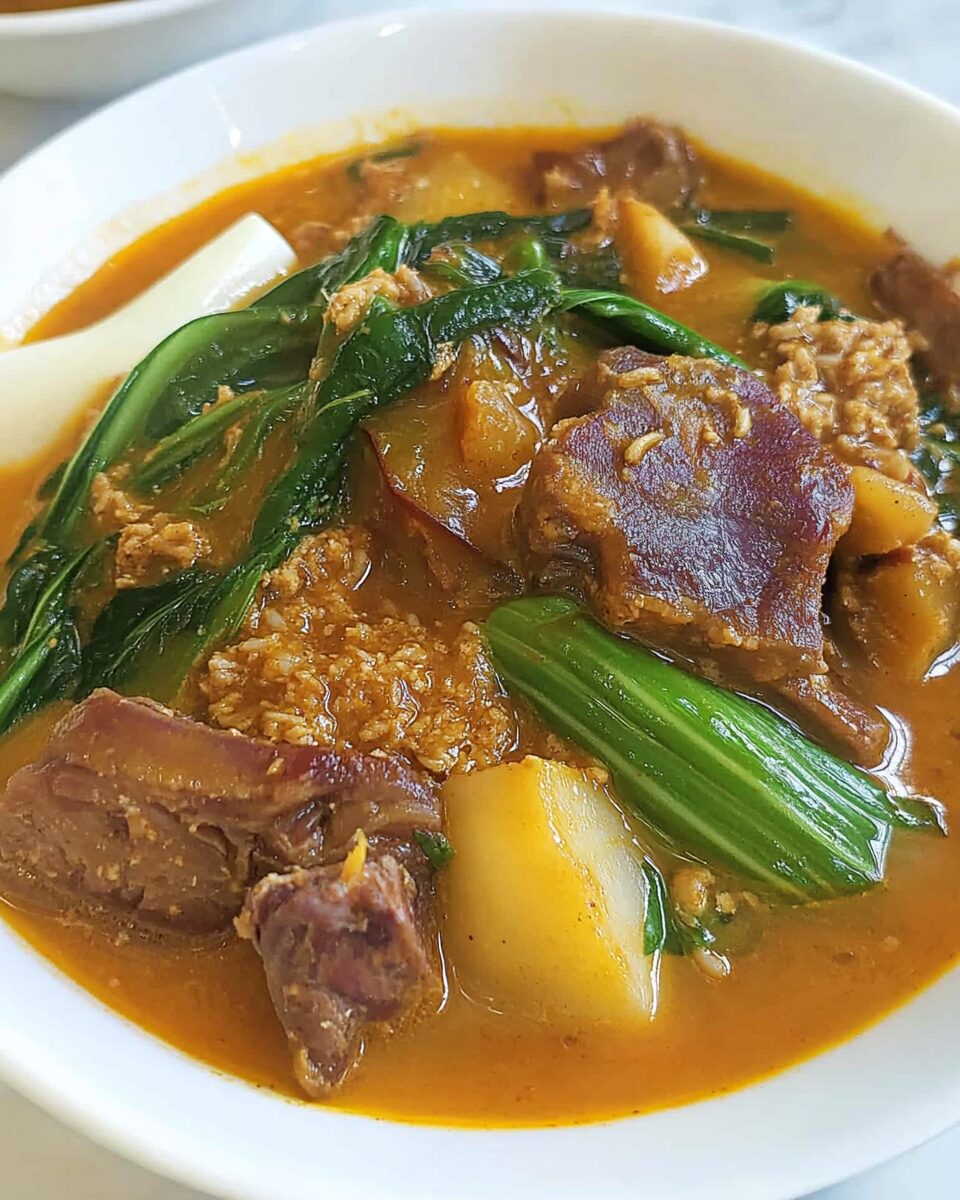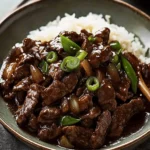Kare-Kare is a traditional Filipino stew renowned for its rich, thick peanut sauce. Often prepared with oxtail, tripe, and a variety of vegetables, this dish is a staple during festive occasions in the Philippines. Its unique flavor is complemented by a side of sautéed shrimp paste (bagoong), enhancing its savory depth.
FULL RECIPE:
Ingredients
- 1/4 kg beef
- 1/4 kg tripe
- 1 cup peanut butter
- 1/4 cup ground toasted rice
- 1/2 cup cooked bagoong alamang (fermented shrimp paste)
- 1 large onion, diced
- 3 cloves garlic, minced
- 1 tablespoon annatto seeds
- 2 eggplants, sliced into 1-inch thick pieces
- 1 bundle bok choy (pechay)
- 1 bundle string beans, cut into 2-inch lengths
- 1 bundle okra
- 3 tablespoons oil
- 5 cups water
- Salt to taste
Directions
- In a large pot, boil the beef and tripe in 5 cups of water for about an hour or until tender. Once cooked, strain and reserve the stock.
- In a separate pan, heat 3 tablespoons of oil and add the annatto seeds. Cook until the oil turns reddish, then remove and discard the seeds.
- Using the annatto-infused oil, sauté the minced garlic and diced onions until golden brown.
- Add the boiled beef and tripe to the pan, stirring well to combine with the aromatics.
- Pour in the reserved stock, then add the peanut butter and ground toasted rice. Stir continuously to ensure the peanut butter dissolves completely.
- Bring the mixture to a boil, then reduce the heat and let it simmer for 15 minutes, allowing the sauce to thicken. Season with salt to taste.
- Add the sliced eggplant, string beans, bok choy, and okra to the pot. Cook for an additional 5 minutes, ensuring the vegetables are tender but not overcooked.
- Remove from heat and serve hot with steamed rice and a side of cooked bagoong alamang.
Nutrition Facts
- Serving Size: 1 cup
- Calories: 478 kcal
-
Total Fat: 21 g
- Saturated Fat: 8 g
- Unsaturated Fat: 13 g
- Trans Fat: 0 g
- Cholesterol: 0 mg
- Sodium: 600 mg
-
Total Carbohydrates: 20 g
- Dietary Fiber: 6 g
- Sugars: 6 g
- Protein: 14 g
The Legacy and Cultural Significance of Kare-Kare
Kare-Kare is one of the most cherished and iconic dishes in Filipino cuisine, embodying a deep cultural heritage that has been passed down through generations. More than just a meal, Kare-Kare represents a connection to tradition, family, and communal dining, making it a staple at celebrations and gatherings. Its presence on the Filipino dining table, particularly during fiestas and special occasions, reflects the value of food as a means of bringing people together. This dish is often associated with the Kapampangan region, which is known for its rich culinary tradition. However, the origins of Kare-Kare remain a subject of debate. Some historians suggest that it was influenced by Indian, Spanish, and Moro cuisines, while others argue that it was a purely indigenous creation that evolved through the ingenuity of early Filipino cooks.
A Dish Rooted in Filipino Ingenuity and Resourcefulness
One of the most fascinating aspects of Kare-Kare is the resourcefulness involved in its preparation. Traditionally, this dish was made using oxtail, tripe, and other less popular cuts of beef. These ingredients required slow cooking to break down their tough connective tissues, transforming them into a tender, gelatinous delight. This method of cooking reflects the Filipino approach to making the most out of every ingredient, ensuring that nothing goes to waste. The sauce, which is the defining feature of Kare-Kare, is made from peanuts, either ground or in the form of peanut butter. This creamy, nutty sauce is thickened using toasted rice flour, another example of how Filipinos have long used natural, accessible ingredients to achieve depth and texture in their dishes. Instead of relying on artificial thickeners, the traditional method enhances the flavor while maintaining the authenticity of the dish.
The Complex Flavors and Cooking Techniques Behind Kare-Kare
Kare-Kare is a dish that requires time and patience to prepare, but the end result is a flavorful, well-balanced meal that delights the palate. Achieving the perfect balance of flavors in the sauce is crucial, as it should not be overly sweet or too thick. The key is to extract the maximum flavor from the peanuts while ensuring that the dish retains a smooth, velvety texture. To prepare the sauce, peanuts are either roasted and ground manually or substituted with peanut butter. Roasting the peanuts before grinding them enhances their natural oils, bringing out a deeper, more aromatic flavor. Some cooks even add annatto seeds, which give the sauce its signature golden-orange hue. While the annatto seeds do not contribute much to the taste, they provide an appealing visual contrast that makes the dish more appetizing. The slow cooking process is what truly elevates Kare-Kare.
Bagoong: The Essential Companion to Kare-Kare
While the peanut sauce in Kare-Kare is already flavorful on its own, the dish is not complete without bagoong alamang, a fermented shrimp paste that adds an intense umami kick. This condiment is an essential element of Kare-Kare, as it provides the saltiness that balances out the richness of the peanut sauce. There are different ways to prepare bagoong. Some prefer it raw, straight from the bottle, while others sauté it with garlic, onions, and a bit of sugar to enhance its depth of flavor. Some households even customize their bagoong by adding pork bits or a dash of calamansi juice for a hint of acidity. Regardless of the preparation method, bagoong plays a significant role in elevating the taste of Kare-Kare.
The Evolution of Kare-Kare in Modern Filipino Cuisine
As Filipino cuisine continues to evolve, Kare-Kare has also undergone various transformations. Many restaurants and chefs have experimented with unique versions of the dish, incorporating contemporary cooking techniques and innovative ingredient choices. One popular modern take on Kare-Kare is the Crispy Kare-Kare, where deep-fried pork belly or crispy pata replaces the traditional slow-cooked meat. This version offers a textural contrast between the crunchy skin and the creamy peanut sauce, making it a favorite among food lovers who enjoy a mix of textures in their meals. Seafood Kare-Kare has also gained popularity, particularly in coastal regions. This version uses shrimp, squid, mussels, and even crab, providing a different depth of flavor while still maintaining the essence of the dish. The natural sweetness of seafood blends well with the peanut sauce, creating a lighter yet equally satisfying alternative.
Advertisement
Conclusion
Kare-Kare is a dish that embodies the depth and richness of Filipino cuisine. Its origins may be debated, but its impact on Filipino culture is undeniable. More than just a stew, Kare-Kare represents the Filipino spirit of resilience, resourcefulness, and the ability to turn simple ingredients into something extraordinary. The preparation of Kare-Kare requires patience and skill, but the effort is always worth it. Whether cooked in its traditional form or reinvented with modern variations, this dish remains a beloved part of Filipino dining. Its creamy peanut sauce, tender meat, and fresh vegetables create a harmony of flavors and textures that make it one of the most comforting and satisfying meals in Filipino cuisine.






